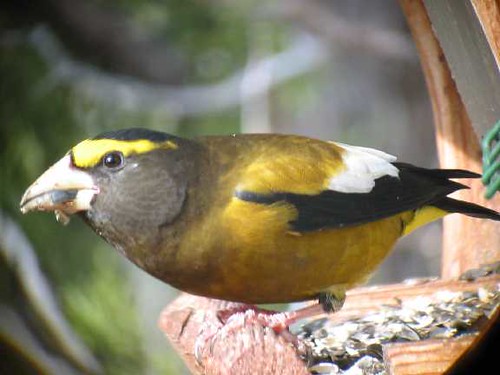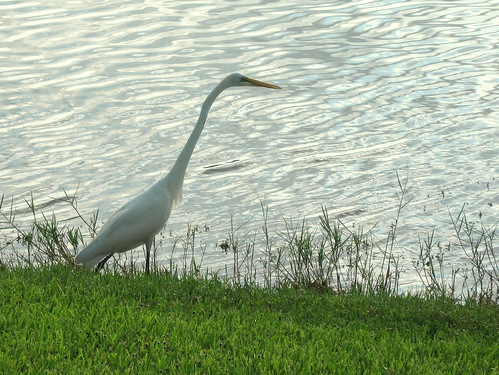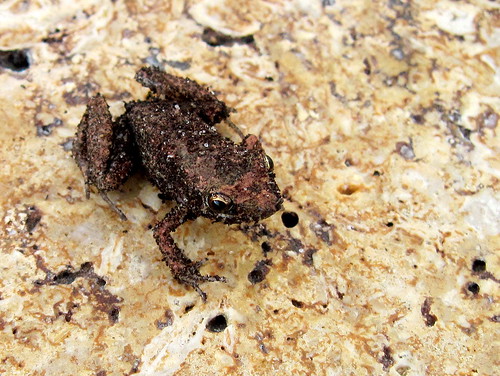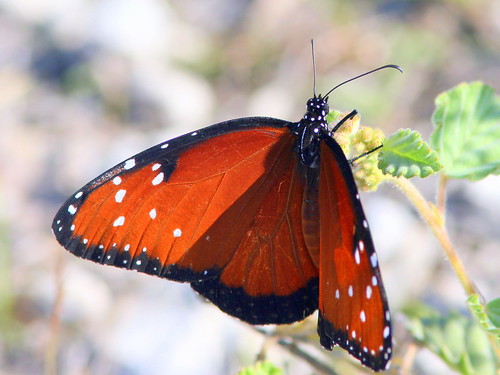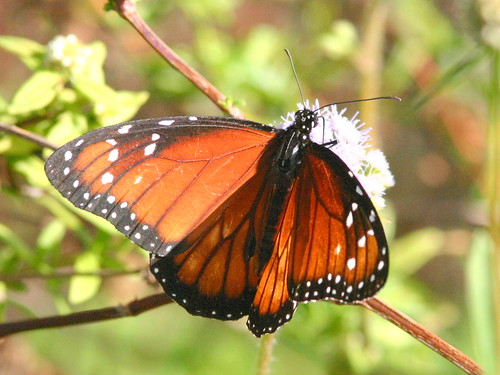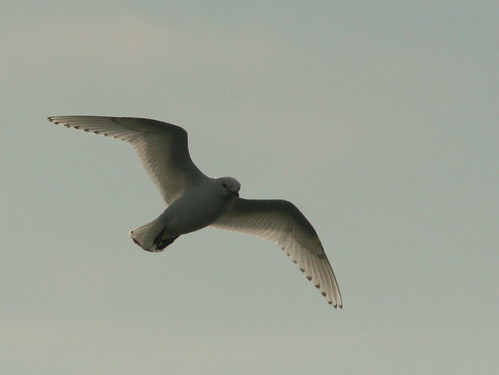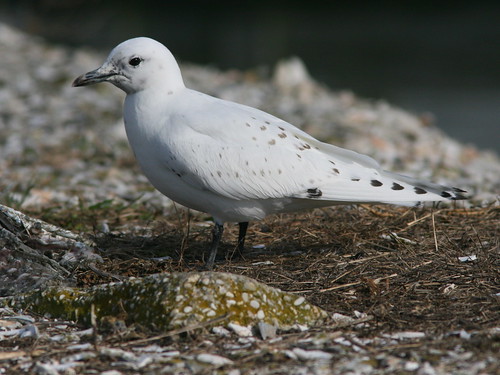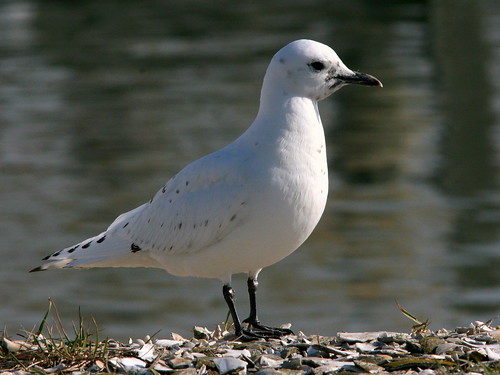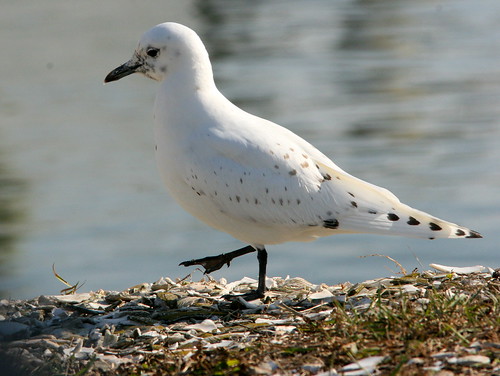Posted by: Ken @ 10:46 am
This Evening Grosbeak at my front yard feeder in New Mexico (February 2003) was one of my first digiscoped photos. It was taken from inside our living room window through a Kowa spotting scope with a little Canon PowerShot A40– only 2 megapixels! Today I’d be pleased to get such a shot with my ginormous DSLR, but am not expecting to see one in Florida!.
I still have my handwritten notes on my first sighting of Evening Grosbeaks on October 21, 1951, Life Bird #154, a flock of about a dozen at Garret Mountain, N.J. (reservation). They were gathered in a small leafless tree, a sight burned into my memory. In a boastful footnote I quoted Alan Cruickshank’s 1942 edition of “Birds Around New York City: Where and when to find them,” under Eastern Evening Grosbeak.
“Seen… as early as November 15, 1915…and as early as October 27, 1927… but such dates are exceptional as the bird seldom arrives before Christmas, and the large majority of records are grouped in January and February…The recording of this species in the New York City region is still a red-letter occasion, and I know many an active observer who is yet to see this species locally.”
Actually there had been a large flight the previous winter, but none showed up near my home in Rutherford, and I was met with skepticism by the veterans when I reported my sighting to the Hackensack Bird Club at their next meeting in Odd Fellows Hall.
William J. Boyle wrote, in “The Birds of New Jersey” (2011) that there had been major flights since that time into the 1980’s. Only 9 individuals had been recorded in four CBCs since 1998.
I prepared this blog for the ABA “Bird of the Year” Evening Grosbeak Blog Carnival but because of other demands on my time I forgot to post it! However, is is up in time for the Bird D’pot
and Wild Bird Wednesday!
Posted by: Ken @ 9:36 am
by William J. Boyle, Jr
Kevin T. Karlson, Photographic Editor
Princeton University Press
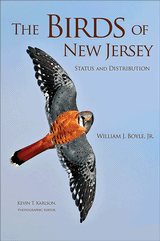
This attractive book, by the author of A Guide to Bird Finding in New Jersey, is packed with information about the historic and present abundance and distribution of the 465 (including extinct) bird species ever officially recorded in New Jersey. For over 450 species there is an emphasis upon population trends and changes in range over the past ten years. The large number of species is a reflection of the great variety and richness of habitats in this small and densely populated state.
These general natural bio-geographical regions are further refined and subdivided in the narratives:
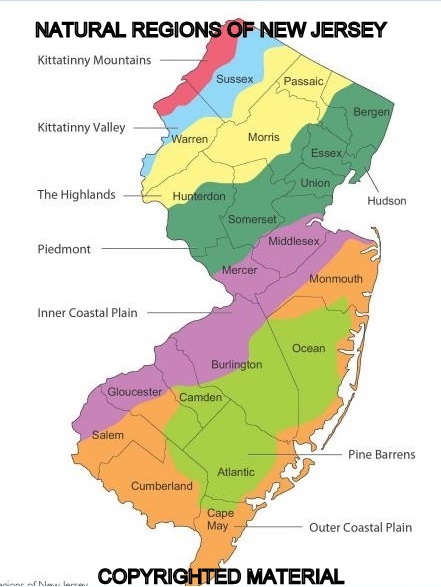
The Introduction includes a brief description of the geography and natural regions of New Jersey. There is a review of the history of previous systematic records of birdlife in the state, beginning with an 1897 compilation by the Fish and Game Commission, up to the most recent work of the New Jersey Bird Records Committee, and current data from eBird and regional rare bird alerts and birding hotlines. In 1998, the State List included 443 species; an additional 15 new species have been documented since then. Adjustments due to splits, and re-evaluation of a specimen and previous records resulted in an official net increase of seven species.
For each species as appropriate, there are notes about approximate migration and breeding dates, as well as habitat descriptions. In some instances, abundance is related to such factors as tree crops and unusual weather disturbances. Large and legible colored maps detail the seasonal distribution of the more common birds, while rare sightings may be shown as dots, with descriptive details for species seen five or fewer times during the past decade. Species that may be found only in a small or restricted area are given special attention.
Species accounts are notably up to date, as illustrated here: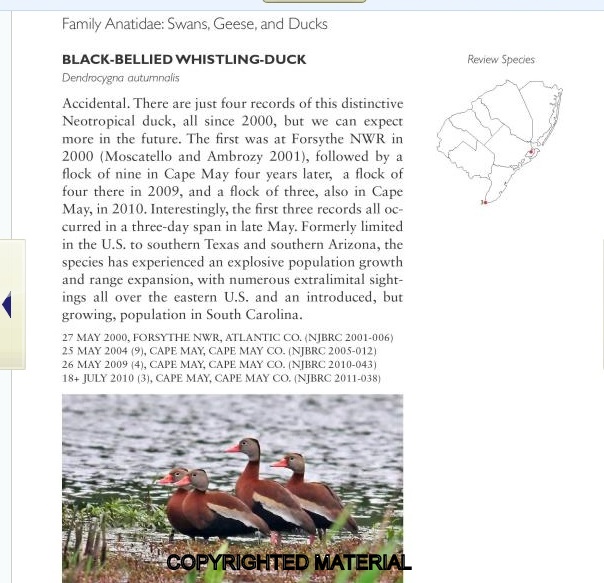
There are over 200 color photographs taken within the state, including both common and rare species. Some of the photos are included for their historic rather than aesthetic value, to document occurrence of rarities. Appendices address exotics and species of uncertain provenance, species referred to in earlier lists or publications as having been seen in New Jersey, but presently not accepted the NJ Bird Records Committee, review species (reports of which require additional documentation), and additional identification information for certain photos.
My interest in birds developed during early childhood in New Jersey in the 1940s. Those were the days before completion of the NJ Turnpike and Garden State Parkway, before people asked “which exit?” when they heard someone was from New Jersey. I grew up in Rutherford, located in the northeast part of the state, only six miles from New York City, and became quite familiar with neighborhood bird species. The mostly undeveloped flood plain of the Passaic River was a five minute walk from my home, and a short bicycle ride took me “down the dumps,” as my friends and I then called the most accessible portion of the meadows along the Hackensack River.
I learned to identify birds at a very early age, collecting bird pictures from Arm & Hammer Baking Soda boxes. My first “real” bird guide was a small format book by Chester A. Reed, Land Birds East of the Rockies. There was a picture of a different bird on each page with descriptive text next to it. As I identified each bird in the book, I penciled across its picture in big block letters: “SAW.”
As a Boy Scout, in the winter of 1948, in quest of a merit badge, I suddenly began keeping an orderly list of the birds I saw. With Monkish precision I drew grid lines on 4×7 loose leaf sheets, with headings: “Name of Bird… Date Seen…Where the Bird was Seen… ,” and numbered each entry. I used my date stamp as if it had the power of a wax seal that certified the authenticity of my sightings.
Here are the first two pages of my Life List:
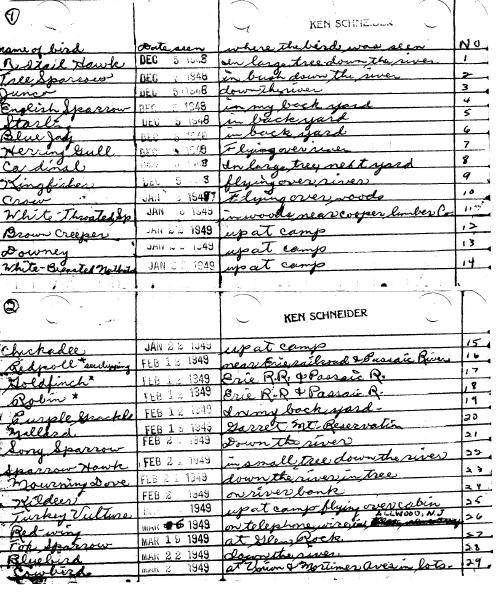
My notes gave special names for many of the sandy hills, wetlands and and woodlands along the Passaic River that harbored the nests of herons, thrashers and cuckoos. They all have since disappeared, swallowed up by housing developments. The Meadowlands Sports Complex now covers one of my favorite “dumps.” Another particularly smelly one, in Lyndhurst, later earned the respectable name of “landfill” and grew into “Mount Trashmore.”
Now my “dump” is known as Kingsland Outlook, part of Richard W. DeKorte Park, famous as a birding hotspot: 
I witnessed great changes while confined to my small corner of New Jersey during the ten or eleven years before 1953, when I got my driver’s license and graduated from high school. In later years, my written records addressed mostly rarities and new life sightings.
In the 1940s, pesticides were used copiously to fight Dutch Elm disease, and surely killed American Robins and Wood Thrushes by the hundreds and thousands. Weakened and dying birds appeared on neighborhood lawns and estates. My cousins and I collected some of these “tame” birds in cardboard boxes and fed them water with an eye dropper, thinking that perhaps they were suffering from starvation or heat stroke, but they all died under our care. My father said he thought they may have been poisoned, but I didn’t connect their deaths with the tree spraying program. It was nearly twenty years later that Rachel Carson’s Silent Spring alerted the world to the dangers of pesticide misuse.
In the early 1940s it seemed that every suburban home had Wood Thrushes nesting in their foundation plantings. In springtime, colorful warblers and other neotropical migrants adorned the leafless trees and shrubs. Peregrine Falcons (then called “Duck Hawks”) nested in aeries high on the Palisades along the Hudson River. I looked forward to perusing Boyle’s book with a Rip Van Winkle mind-set, ready to be surprised by the changes in the number and distribution of New Jersey’s birds over more than a half century. I was not disappointed.
Paging through this book, my attention was naturally drawn to those old, familiar species of my childhood. How have they fared? Have some of the less common birds changed in abundance? Have new species invaded my old turf? It was a relief to find that Wood Thrushes remain abundant. Of course, House Finches and Cattle Egrets were unknown to me in the 1940s, and I was aware of how they invaded New Jersey by the 1970s, but from Boyle I learned that numbers of both species have since plummeted. Bacterial conjunctivitis caused a 50% drop in House Finch populations in the late 1990s, though they are still widely distributed in the state. The number of breeding Cattle Egrets peaked in the 1980s, but now the breeding population has nearly disappeared from New Jersey.
At ten or eleven years of age, I received the gift of a used copy of Allan Cruickshank’s 1942 book, Birds Around New York City: Where and When to Find Them. Its coverage area included all of northeast New Jersey, and it became my benchmark reference, and sometimes a source of pride when I found a new bird. It also spurred me to begin keeping records of my observations, which I peppered with citations from Cruickshank’s book.
Common Redpoll, February 12, 1948, Rutherford - “This northern finch… is a decidedly irregular winter visitant, usually very rare…In most counties it is recorded only three out of every five years [Cruickshank page 442].”
Iceland Gull, December 26, 1949, Belleville - “It is …still and uncommon to rare winter visitant in the New York City region, and a recording of the species continues to give local enthusiasts a great feeling of satisfaction [Cruickshank page 223].”
Boyle indicates that both species remain scarce. The redpoll is still rare to uncommon as a winter visitor or migrant. The Iceland Gull’s numbers peaked in the 1970s, and they have become less numerous in recent years.
“Eastern” Evening Grosbeak, October 21, 1951, Garret Mountain - “Seen as early as November 13, 1915… and October 27, 1927 …but… the bird seldom arrives before Christmas…the recording of this species in the New York City region is still a red-letter occasion, and I know many an active observer who is yet to see this species locally. [Cruickshank, page 438].”
Boyle reports that Evening Grosbeaks increased substantially, beginning with an incursion during the winter of 1950, peaked in the 1970s, but “have declined markedly since the mid-1980s.”
“Eastern” Glossy Ibis, April 26, 1952, from the boardwalk at Troy Meadows - “An accidental visitor from the south…(seen) at Troy Meadows, New Jersey …May 26, 1937… (and) May 21, 1939… In recent years there have been marked flights just to the south of us, and there are now many records for southern New Jersey. [Cruickshank, page 79]”
My Glossy Ibis sighting, the first northern New Jersey record in 13 years, was never officially accepted. A few days after seeing it, I duly reported it at a meeting of the Hackensack bird club at Odd Fellows Hall. My companion at Troy Meadows had been an older but less experienced birder, who also saw the unmistakable crow-black long-legged heron-like bird, flying with its extended neck and long decurved bill. He stood up with me to “verify” my identification before those in attendance. My age put me at a disadvantage, and our report was met with insulting comments, such as “Why didn’t you put salt on its tail, Sonny?” I left the meeting thoroughly humiliated, resolved that I would never again associate with this “old man’s club!”
Imagine my surprise to learn from Boyle’s narrative that the first Glossy Ibis nest in New Jersey was found in 1955, and that the species was, by 1978, “the most common colonial waterbird in the state.” Even more surprising is the fact that its population crashed during the next twenty years to only “350 to 400 birds, about 10% of the 1978 population.”
I never saw a Red-bellied Woodpecker during the 1940s and 1950s, though it expanded its range in the 1960s and 1970s, and now the species is common and widespread in New Jersey.
The Tufted Titmouse was just invading northern New Jersey when I saw my first one on May 15, 1949 in the Overpeck Creek area on a “Big Day” with Floyd Wolfarth and Louis Fink, two prominent local birders. I did not see my first local Northern Mockingbird until 1960, though they now may be found commonly in most parts of New Jersey.
The approximate line of demarcation separating the ranges of Black-capped and Carolina Chickadees still appears to be the Raritan River, just as it was when I was a child, but I now learn from Boyle that there is an “island” of the Black-capped species at Sandy Hook. This is useful information for any birder planning a visit.
White-crowned Sparrows were never very numerous, and they rarely spent the winter in my neighborhood. Now they are uncommon but regularly found during the winter.
These are but a few of the memories stimulated by my perusal of the contents of The Birds of New Jersey. It is an important and timely addition to the fund of knowledge about the rich avifauna of the Garden State. Resident birders will surely refer to it frequently. Any birder who is planning a visit to the state will find this to be a most useful resource.
Also available from Amazon,com
Kindle Edition $9.99
Hardcover $55.00
Paperback $16.47
Page images are from Amazon.com’s “Look inside The Birds of New Jersey: Status and Distribution“
Posted by: Ken @ 10:28 pm
Today, fast approaching the three-quarter century mark, I am penning my 300th post in Rosyfinch Ramblings. Before the days of File Transfer Protocol, and before the word “blog” was invented, I created the rosyfinch.com web suite devoted to the birds of the Sandia Mountains, near our former home in New Mexico. In those days I wrote daily updates in HTML code by hand, and uploaded strings of ASCII characters via a telephone modem. When I started using blogging software in 2006, I simply intended to record memories from my childhood in New Jersey. In my fifth post, Discovering Birds, I tried to remember how and why I ever got into bird watching.
How lucky I was to have had a father with an infectious interest in the natural world. I remembered those long walks with him in the woods (Habitats and Inhabitants) and, more recently on Father’s Day, described how I especially felt his his loss. Now we and our children try to inspire our grandchildren to put away the Wii’s, Game Boys and iPods and get outdoors. See Birders Start Young, and Early Birder.
I recounted adventures from my medical career, as the Rookie Doctor in Town , and wondered Why It’s Called Medical “Practice”. Then, suddenly and unexpectedly, I entered the field of public health, only two weeks after receiving a telegram: Greetings, You’ve Been Drafted . Providing medical care in the aftermath of Hurricane Camille, and Closing the Grand Canyon were but a couple of highlights of many exciting experiences in public health practice.
I always wanted to marry a bird-watcher, but this never happened until after I retired to the mountains of New Mexico. Don’t look so startled– Mary Lou and I just celebrated our 50th Wedding Anniversary, but she suffered as an SOB (spouse of a birder) for many years before I could say “Finally, I’m Married to a Bird-Watcher.“
We do not feel the need to travel far and wide to enjoy the beauty of nature, whether from the windows of home, in backyards, or in local patches of semi-wild land. From early childhood, I have found Beauty in the Commonplace, mostly in the good old USA. While Mary Lou and I keep life bird lists, and have taken several wildlife-oriented jaunts and cruises, neither of us has a compulsion to see all the birds of the world. We greatly enjoy seeing just that tiny sample of the avian multitude that live in, or visit our neighborhood.
Muscovy Duck in flight:
No, this is not a Frog-mouthed Four-legged Crow, but rather part of a ritualistic encounter between two male Boat-tailed Grackles in our yard. They take turns posturing, and soon one will open his mouth and flap his wings while the other points his bill to the sky. They posture and then the other bird does the same. At no time did both birds sing and flap at the same time. This went on for several minutes, until they peacefully walked away from each other and resumed catching dragonflies on the lawn. Click on image and view sequential photos of the “dance” at the “comment” link below the photo.
Boat-tailed Grackles perform a ritual “dance:”
I’m still experimenting with my little Canon A-1100 IS point-and-shoot. It packs 12.1 megapixels. This is a cropped image zoomed 4x optically to about 25 mm focal length. If you click on the photo, an image will appear below it, lightly cropped and not zoomed at all, about 6mm focal length:
Great Egret:
The Canon A-1100 takes surprisingly sharp macro photos, such as of this Garden Snail (Zachrysia provisoria):
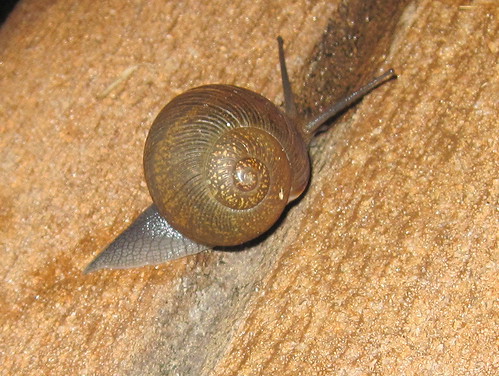
This big Lubber grasshopper was on the glass of our patio door, again captured by my little point-and-shoot:
I had been hearing little chirps in my garage in the vicinity of the corner where I store my fertilizer and garden stuff. The chirps would stop whenever I got near, and I could not find their origin, though I presumed it might be a tree toad or frog, or maybe a Mediterranean Gecko. When potting a plant one morning I reopened a bag of potting soil. Inside were at least 6 or 7 of these little frogs, about 3/4 inch in length. Greenhouse Frogs live in plant litter and their tadpoles develop into frogs inside the eggs, so they don’t need a pool or pond to breed. They lack webbing between their toes and have been erroneously called toads. Native to the Caribbean, they have invaded most of the Florida peninsula. Listen to an mp3 of their little chirps that I heard: puca.home.mindspring.com/mp3s/Greenhouse.Frog.mp3
A Green Heron dropped by our back patio just before we departed for Illinois:
When the birding slows down there are always butterflies, and it is fun to separate the Queen…
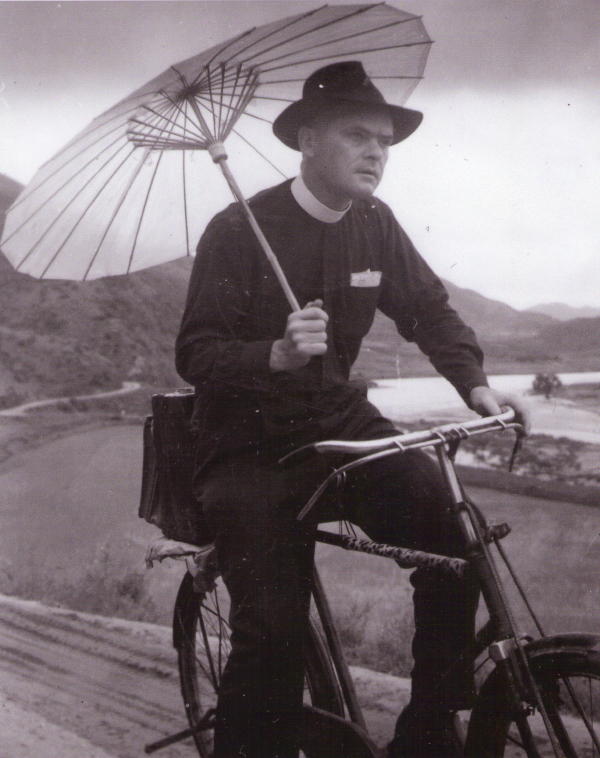
Father J. Daniel (Dan) Schneider in Korea, ca1955
My father’s brother died four weeks ago. Yesterday we received a letter from him.
“Now that Father Dan is gone,” our eldest daughter had lamented. “there’s no one left who will write letters to me.”
They were frequent correspondents. What they wrote to each other I don’t know, but Karen felt a special bond with her great-uncle. At his funeral, others of her generation (Karen was the first of his 69 grand-nieces and nephews) echoed her sentiment– each felt that he or she was his favorite person in the world. I felt that way too, when, as a teenager, we exchanged trans-oceanic air mail letters.
At the very least, each of his friends and relatives received an annual Christmas message. In the old days it was typed out laboriously– at first, mimeographed, later photocopied, complete with strike-throughs and typos. Usually his letter included a personal handwritten addendum. Several years ago, Dan entered the computer world, and this increased his output.
My Uncle remembered so many small details and family stories– things that many of us had long forgotten. Like Biblical parables, his anecdotes were lessons of hope and optimism. Father Dan seemed to remember each and every family baptism and wedding in which he officiated during more than 60 years of priesthood. He wrote memoirs and a family history.
This excerpt concerned his father’s difficult childhood in Columbus, Ohio:
My father left school in the fifth grade to go to work because his father’s TB made it impossible for him to continue to work as a blacksmith. He got his first job delivering telegrams for Western Union. He’d bring home two dollars a week. He was paid on Friday and grandma would go out at eight o’clock at night and buy the groceries for the whole week for $2 – this for a family of five.
One day my father was given a telegram for Mr. Joyce, president of the Green Joyce Dry Goods company. He was told not to deliver it to anyone but Mr. Joyce. So he went to the office with his telegram for Mr. Joyce. The secretary said that he wasn’t available and that he should leave it with her. My father insisted, “I must give the telegram to Mr. Joyce and no one else. I’ll wait.”
Finally after an hour or so, Joyce arrived and heard the story of the messenger who waited to give him the telegram. He called my father in.
“Sonny, my secretary tells me you waited over an hour to deliver this telegram. Why did you do that?”
“Sir, I do what I’m told,” my father said. “I was told this was to be delivered to you and no one else, and I was prepared to stay all day.”
“Sonny, how would you like working for me? You’re the kind of person I’d like to hire.”
My father took the job and doubled his salary to $4 a week. He started sweeping floors. Then he stocked shelves and kept inventory. Then he became a salesman. Green Joyce was a clothing and notions wholesaler. He would sell hats, overshoes, coats, gloves, and other ready-to-wear clothing, plus buttons, ribbons, cloth, and everything else people needed to make their own clothes. He criss-crossed Southern Ohio on the train, carrying his sample case, visiting all his accounts. He would watch the weather. He’d tell his stores when a bad winter was coming, and advise them to stock up on cold-weather gear. He was very good at this.
Finally he became president of the company. From janitor to president – an American story…
Reflecting upon his vocation, Father Dan wrote:
The first thought I ever had about the foreign missions was when I was in the third grade at Holy Name School in Columbus, Ohio. A priest came in and showed us a movie of missionaries in China. We watched this guy in all his priestly clothes walking along in a rice paddy. He had a big hat on, and he was surrounded by people planting rice in the rain. All I could think of was, after I saw that movie, “the one place in the world I’d never, never want to go is China or any part of the Orient.” The heat, the dirt, the poverty – it repelled me. 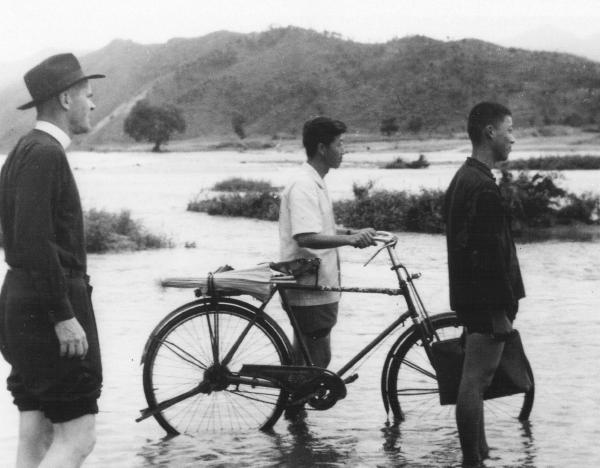
A college journalism major, Dan’s first priestly assignment as business manager and promoter of The Field Afar, his Maryknoll Society’s little magazine, seemed mundane, but with his efforts, circulation increased from 150,000 to 500,000 in less than four years. He learned the Korean language, and labored for over 20 years in South Korea, finally becoming Regional Superior for the Korean missions. From 1974 until 2001 he worked as a parish priest in Kansas City, Missouri and Overland Park, Kansas, serving as Spiritual Director of the Korean Catholic Community and as an active minister for Engaged and Marriage Encounter programs.
Father Dan wrote about his own father’s reaction to his decision to become a priest. He was very proud when his son got accepted to the Wharton School of Finance at the University of Pennsylvania. Then, after Dan turned down a scholarship in their MBA program, he did his best to not show his disappointment.
Years later, when we were able to talk freely together, he told me that my decision was the greatest disappointment he ever had. He and my mother were passionate about giving their children an education… He said, “When you told me about Maryknoll, it crushed me. I thought that going to China was the dumbest thing I ever thought of.” He told me this years later. Outwardly he supported my decision. And later he was genuinely happy at my ordination, and proud of the work I did in the order. But it was a different story when he first heard the news…
My mother was the happiest of all. She always wanted one of her sons to be priest. She probably wouldn’t have minded if all her sons became priests. The sad thing is that she didn’t live to see it. She died in October, 1943. I was ordained in June, 1945.
These words remind me of my Grandmother Nora, whom I called “Schotzie” (read more about her here). As a six or seven year old child, I so enjoyed visiting their big house in Rutherford, New Jersey. One day she was expecting Dan to bring a large group of fellow seminarians home for dinner. Schotzie must have spent all day getting ready for their visit. She put out their best linens, and to be sure that nothing was disturbed, she also pinned little notes on the towels in the bathroom: “DO NOT USE.”
The seminarians arrived, and when they came back from washing their hands, they were dripping wet. My grandmother had forgotten to remove the signs!
Father Dan so enjoyed people and parties, and loved food. His boundless energy seemed to keep him from becoming obese. Sometimes, in intense conversations, he shared his own pain unabashedly, in a way that lifted up our own burdens. Father Dan had time for everyone.
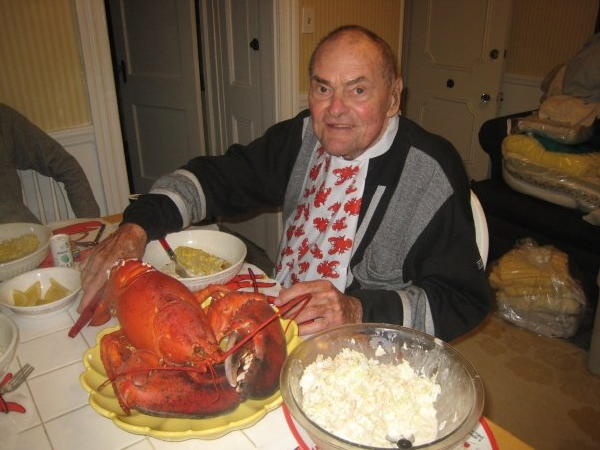
Father Dan’s spirituality went beyond the bounds of dogma and ritual. He encouraged my love for the outdoors and all wild things. He told of a younger priest in Korea who had been doing some great things in his area.
One day he took me to visit one of his Buddhist friends – the first Buddhist monk I’d ever met. The guy was a college graduate; he spoke English far better than I spoke Korean. We had a wonderful conversation. At the end, I invited him up to my parish to give a talk on Buddhism, and he accepted. I happened to mention this casually to Bishop Pardy. He was stunned. He says, “You’re going to do what? You’re going to bring a pagan in to talk to your Catholics? Do you realize you’re going to endanger their faith? They might want to become Buddhists.” He forced me to cancel the invitation, which I did very unwillingly.
That goes to show you how my thinking had already changed. The Vatican Council had not yet taught a different approach to other religions. I had been taught in the seminary that Buddhists are atheists, that Buddhism was a terrible religion, the devil’s religion. They taught that in the seminary, and then I met some Buddhists and found them to be wonderful people.
Some time later a priest from the U.S. came over and gave us a retreat. He asked me to introduce him to a Buddhist monk. I took him to a monk in a hermitage nearby, a man who spoke English. I said, “This is Fr. Fraser. He teaches theology in New York in America. He has a question.”
“Father, what’s the question?” the monk said. It is, “Are Buddhists atheists or agnostics, or do they believe in God?” The monk walked over to a dogwood tree in his garden. He put his fingers on the trunk of the beautiful tree and said, “For the Buddhists that is God.”
His love of beauty moved me. But of course he really didn’t answer the question. Or he answered it in an enigmatic Buddhist way. Buddhists don’t use the word, “God.” I think Buddhism is more of a philosophy than a religion.
About ten years ago, when he was ministering to the Korean community in Kansas City, Father Dan told me he was feeling very jealous because a younger priest was going to replace him. In his memoirs he relates the remarkable story of his replacement:
For many years I pastored a small congregation of Koreans in Kansas City. I had retired from Maryknoll at age 65, and at age 75 the bishop agreed to replace me as pastor of this Korean group. When I was approaching age 80 he finally did something about it. We found a priest in Los Angeles who was recruiting Korean priests to come to the US, and one of them came to Kansas City.
The priest’s name sounded familiar to me. Had I met his family somewhere? I asked. I’m from Chongju, he said. Your name is Park. Is the name Sylvester Park familiar? He said, “Yes, that was my grandfather.” And I said, “He was my catechist in 1956 when I first came to Korea.”
So there you have it. I went to Korea as a missionary priest and helped build up the Chongju diocese. Forty years later the Chongju diocese sends my catechist’s grandson as a missionary to the United States to replace me so I could retire
In 1997, on the occasion of his 90th birthday, our younger daughter Jackie wrote this to Father Dan:
As I look back at all the letters that you have sent us over the years, even your personal handwritten notes, there is one continuous theme that I see. You are truly a man of God who touches people’s lives with your words and interpretations of how God loves each of us and is alive in our hearts everyday. Father Dan, you have truly touched me with your many insights of how God works in us and through the people who come into (and simply pass through) our lives each day. You have made me believe that there is a reason we are here on this earth, and God’s Will is why things happen. We may not understand our roles during many periods of our life, but if we keep believing and relying on our faith in Him, the answers will come and the rocks (and sometimes boulders) in our path will be pushed aside, and we will see that God is with us through it all.
Father Dan’s name and return address were on the envelope. In past years, his Christmas letter never arrived so late. We opened it:
My younger sister Ellen was a school nurse in the Greenwood Lake area of New York State. She had cared for two generations of students, and, in 2005, she died suddenly and unexpectedly. At her wake and funeral, mourners lined up around the block in the rain, and filled the church to bursting. Father Dan remarked, “If you want a crowd at your funeral you have to die young. Older people outlive all their friends.” Was he ever wrong! His funeral was the best-attended in memory at Maryknoll Seminary.
Also see related Blog post: Saying Goodbye
Late in November the New Jersey Rare Bird Alert reported the sudden appearance of an Ivory Gull in the harbor at Cape May, New Jersey, Only the size of a pigeon and and snow white, this little-known species rarely ventures from the Arctic ice pack, even in winter. I had no idea that I might have a chance to see it. This was only the fifth Ivory Gull ever recorded in New Jersey, the last having been seen in 1986.
The Ivory Gull sighting was far from my mind when we received the sad news of the death, in upstate New York, of my late Dad’s younger brother, Father Dan Schneider (See: Saying Goodbye and A Postscript from Father Dan)
Funeral arrangements were uncertain, so we flew out on Monday, December 7. We later learned that the funeral would not take place until Friday. This left us with some leisure time. We were delighted when, the next morning, my brother offered to drive us down to Cape May to look for the gull.
We did not know the gull’s exact location. Unable to access the New Jersey RBA archives, I sent out a couple of frantic RFI’s to birders who had posted the most recent sighting reports. Luckily, two people replied almost instantly. Without their detailed directions we never would have found the site.
When we arrived at the Bree-Zee Lee Marina we were greeted by other birders who pointed out the gull, perched on a piling about 100 feet offshore, to the south. The sun, behind the bird, reflected harshly off the water, and our binocular views provided little more than a silhouette. Except for its small size, this was not enough to see any identifying characteristics.
Passing fishermen not only gave us a friendly wave, but also blocked out the glare, and the color of the little gull turned from black to snow white: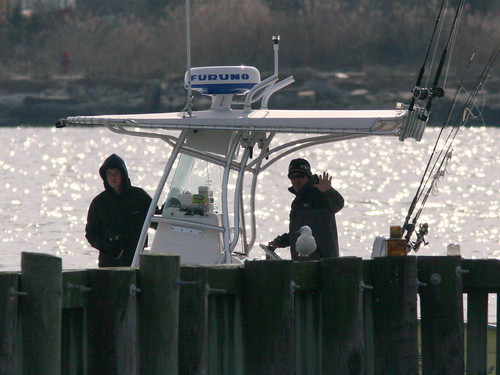
A floating dock extended out to give us a side view, not ideal, but maybe the best we could expect: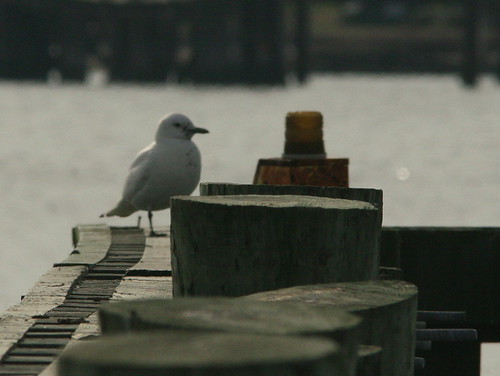
The number of watchers swelled to over a dozen. Kevin Karlson joined us, carrying a the remains of a large fish that his neighbor had given him. He placed it conveniently near our observation point, and assured us that the gull would soon fly in to eat.
Sure enough, within minutes it took wing:
As it approached, the gull dipped to pick something off the surface of the water: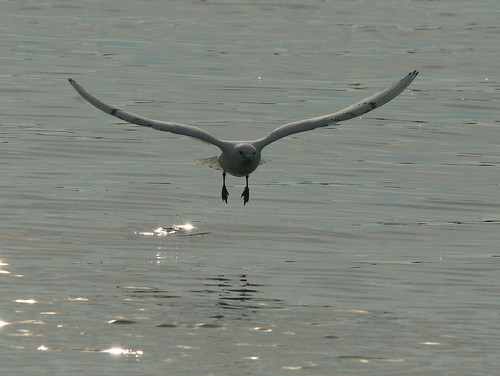
It flew directly to the fish carcass, as Kevin had predicted: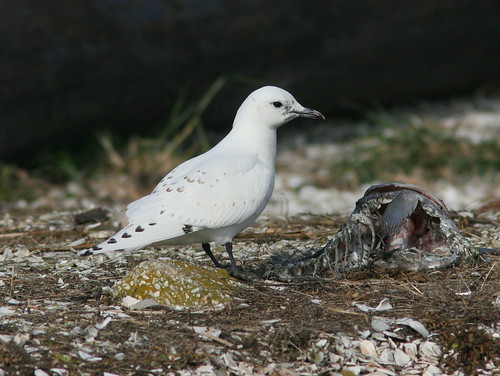
We had knockout views from about 15 feet:
This was a first year bird, as evidenced by its black markings:
With their long optics, birders had no need for a closer approach: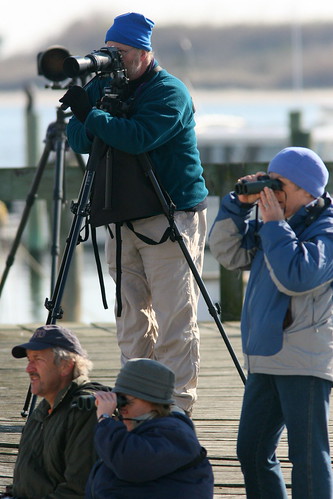
After about 20 minutes, the gull appeared to have gleaned all the remaining meat from the fish head, and became restless:
Then, the Ivory Gull lofted and disappeared into the sun: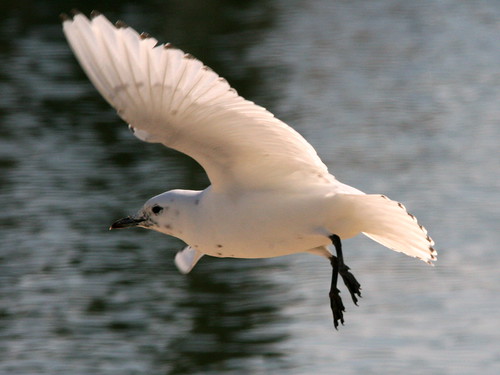
During a storm on December 11, only three days later, the Ivory Gull disappeared and has not been seen since.













